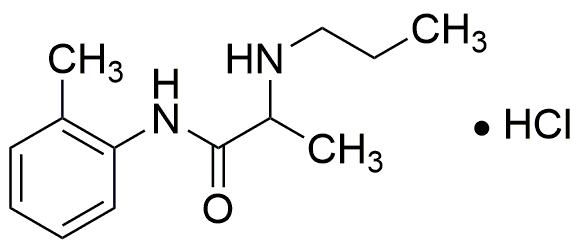Prilocaine hydrochloride is widely utilized in research focused on:
- Local Anesthesia: Commonly used in dental procedures and minor surgeries, it provides effective pain relief with a lower risk of systemic toxicity compared to other anesthetics.
- Topical Applications: Formulated in creams and gels for numbing the skin before procedures like laser treatments or injections, enhancing patient comfort.
- Regional Anesthesia: Employed in nerve blocks for surgeries, offering targeted pain management while minimizing the need for general anesthesia.
- Pharmaceutical Research: Investigated for its pharmacokinetic properties, helping researchers develop safer and more effective anesthetic agents.
- Combination Therapies: Used alongside other anesthetics to improve efficacy and reduce side effects, making it a versatile choice in clinical settings.
General Information
Properties
Safety and Regulations
Applications
Prilocaine hydrochloride is widely utilized in research focused on:
- Local Anesthesia: Commonly used in dental procedures and minor surgeries, it provides effective pain relief with a lower risk of systemic toxicity compared to other anesthetics.
- Topical Applications: Formulated in creams and gels for numbing the skin before procedures like laser treatments or injections, enhancing patient comfort.
- Regional Anesthesia: Employed in nerve blocks for surgeries, offering targeted pain management while minimizing the need for general anesthesia.
- Pharmaceutical Research: Investigated for its pharmacokinetic properties, helping researchers develop safer and more effective anesthetic agents.
- Combination Therapies: Used alongside other anesthetics to improve efficacy and reduce side effects, making it a versatile choice in clinical settings.
Documents
Safety Data Sheets (SDS)
The SDS provides comprehensive safety information on handling, storage, and disposal of the product.
Product Specification (PS)
The PS provides a comprehensive breakdown of the product’s properties, including chemical composition, physical state, purity, and storage requirements. It also details acceptable quality ranges and the product's intended applications.
Certificates of Analysis (COA)
Search for Certificates of Analysis (COA) by entering the products Lot Number. Lot and Batch Numbers can be found on a product’s label following the words ‘Lot’ or ‘Batch’.
Numéro de catalogue
Numéro de lot/série
Certificates Of Origin (COO)
This COO confirms the country where the product was manufactured, and also details the materials and components used in it and whether it is derived from natural, synthetic, or other specific sources. This certificate may be required for customs, trade, and regulatory compliance.
Numéro de catalogue
Numéro de lot/série
Safety Data Sheets (SDS)
The SDS provides comprehensive safety information on handling, storage, and disposal of the product.
DownloadProduct Specification (PS)
The PS provides a comprehensive breakdown of the product’s properties, including chemical composition, physical state, purity, and storage requirements. It also details acceptable quality ranges and the product's intended applications.
DownloadCertificates of Analysis (COA)
Search for Certificates of Analysis (COA) by entering the products Lot Number. Lot and Batch Numbers can be found on a product’s label following the words ‘Lot’ or ‘Batch’.
Numéro de catalogue
Numéro de lot/série
Certificates Of Origin (COO)
This COO confirms the country where the product was manufactured, and also details the materials and components used in it and whether it is derived from natural, synthetic, or other specific sources. This certificate may be required for customs, trade, and regulatory compliance.

